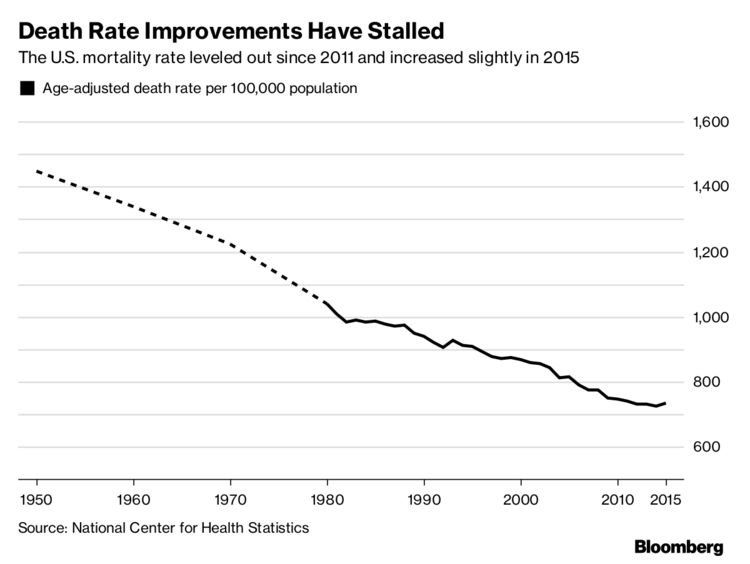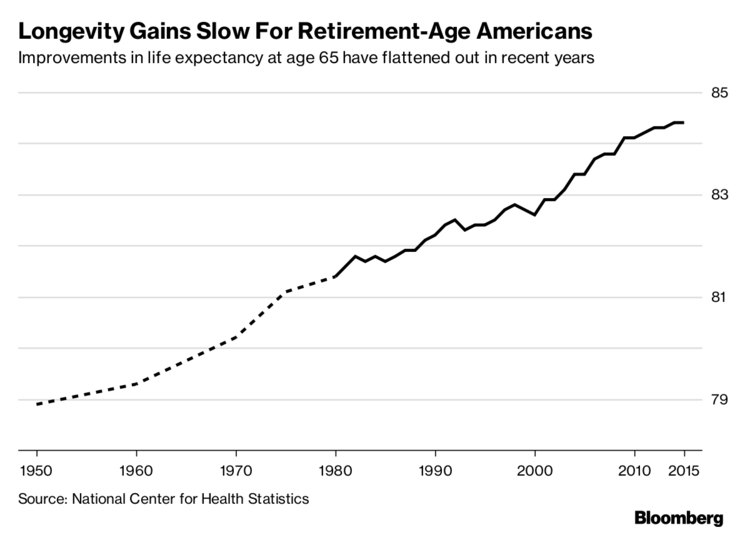Steady improvements in American life expectancy have stalled, and more Americans are dying at younger ages. But for companies straining under the burden of their pension obligations, the distressing trend could have a grim upside: If people don’t end up living as long as they were projected to just a few years ago, their employers ultimately won’t have to pay them as much in pension and other lifelong retirement benefits.
In 2015, the American death rate—the age-adjusted share of Americans dying—rose slightly for the first time since 1999. And over the last two years, at least 12 large companies, from Verizon to General Motors, have said recent slips in mortality improvement have led them to reduce their estimates for how much they could owe retirees by upward of a combined $9.7 billion, according to a Bloomberg analysis of company filings. “Revised assumptions indicating a shortened longevity,” for instance, led Lockheed Martin to adjust its estimated retirement obligations downward by a total of about $1.6 billion for 2015 and 2016, it said in its most recent annual report.
Mortality trends are only a small piece of the calculation companies make when estimating what they’ll owe retirees, and indeed, other factors actually led Lockheed’s pension obligations to rise last year. Variables such as asset returns, salary levels, and health care costs can cause big swings in what companies expect to pay retirees. The fact that people are dying slightly younger won't cure corporate America’s pension woes—but the fact that companies are taking it into account shows just how serious the shift in America’s mortality trends is.
It's not just corporate pensions, either; the shift also affects Social Security, the government’s program for retirees. The most recent data available “show continued mortality reductions that are generally smaller than those projected,” according to a July report from the program’s chief actuary. Longevity gains fell short of what was projected in last year’s report, leading to a slight improvement in the program’s financial outlook.

“Historically, mortality rates annually have tended to come down year-over-year,” says R. Dale Hall, managing director of research at the Society of Actuaries. The professional association compiles mortality data that many private pension plans use in their projections. “There really has been a little bit of slowdown in mortality improvement in the United States,” Hall says.
Absent a war or an epidemic, it's unusual and alarming for life expectancies in developed countries to stop improving, let alone to worsen. “Mortality is sort of the tip of the iceberg,” says Laudan Aron, a demographer and senior fellow at the Urban Institute. “It really is a reflection of a lot of underlying conditions of life.” The falling trajectory of American life expectancies, especially when compared to those in some other wealthy countries, should be “as urgent a national issue as any other that’s on our national agenda,” she says.
Actuaries use two main factors to project death rates into the future: They start with current mortality levels—the percentages of people who die at a given age—and then make predictions about how those percentages might change with developments such as new medical treatments or changes to smoking or obesity rates. For instance, the widespread prescribing of cholesterol-lowering statins in the 1990s was “a huge driver of mortality improvement,” says Eric Keener, senior partner and chief actuary at Aon’s U.S. retirement practice. If medical science produces new treatments for Alzheimer’s disease or cancer, they could have similar effects.

Death rates for Americans over the age of 50 have improved, on average, by 1 percent each year since 1950, according to an analysis by the Society of Actuaries, though there’s a lot of variation in any given year. From 2000 to 2009, that long-term trend seemed to be accelerating, with annual improvements of 1.5 to 2 percent—but then those gains stalled. From 2010 to 2014, death rates were only improving by about half a percent per year.
In 1970, a 65-year-old American could expect to live another 15.2 years on average, until just past their 80th birthday. By 2010, a 65-year-old could expect to live to 84.
But the increases have slowed down since then. Life expectancy at 65 rose by just about four months between 2010 and 2015—half the improvement recorded between 2005 and 2010.








